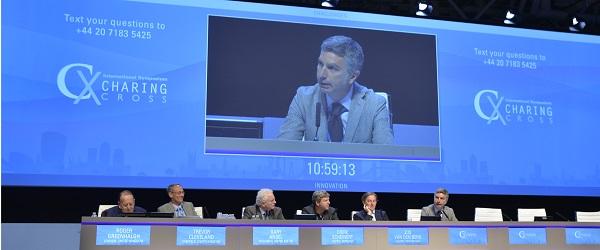
Yesterday, delegates heard brand new data for drug-coated balloons (DCBs) in “wider use” scenarios such as challenging lesions; one-year results for a novel DCB; and late-breaking data on downstream coating effects of various DCBs. Still, 84% of the CX audience said “no” in response to the question: are DCBs equally effective in all lesion subsets? There is still uncertainty in the therapeutic puzzle about which device in the endovascular armamentarium is best suited to treat which lesion.
Clearly, DCBs are here to stay. They have cemented superior effectiveness with respect to achieving patency and reducing clinically-driven target lesion revascularisation over percutaneous transluminal angioplasty in the treatment of uncomplicated lesions. However, questions still remain about the best endovascular treatment strategy for long, complicated lesions and chronic total occlusions, particularly when it comes to durability and long-term follow-up. For challenging lesions, is the best treatment a DCB followed by a bail-out stent? Is it a stent alone? Is it atherectomy, including laser atherectomy, followed by DCB? There is a paucity of data to answer these questions.
“Year-on-year, DCBs have clearly shown that they have a place. The question now is how much further can they go than the treatment of straightforward lesions in the peripheral vascular space?” asked Roger Greenhalgh, London, UK, chairman of the CX Programme Organising Board.
“DCBs can place drug inside a vessel; they cannot change recoil from a calcified lesion and cannot treat a dissection. Until we can get a technology that can do that without a scaffold, stents will play a big part in what we do as we get into more complex lesion lengths, and calcification,” Gary Ansel, Columbus, USA, stated.
Further audience opinion on the role of DCBs was revealed when 54.6% of the audience voted in favour of DCBs as an alternative to stents. Another 39.9% thought these devices should be used for in-stent restenosis; 3% thought they were a last resort and 2.5% believed that they have no role at all.
Yesterday’s Peripheral Arterial Consensus Update saw an exciting main programme with a number of “podium first” presentations, first-in-man and late breaking trial data. In a podium first presentation, Ansel presented one-year results analysing outcomes in patients from the IN.PACT Global Study with complex lesions. The analysis compared standard usage patients (n=281) who met similar inclusion criteria for the IN.PACT SFA pivotal trial, an FDA investigational device exemption (IDE) study, compared with use in a broader spectrum of patients (n=1125) who had wider inclusion criteria reflecting more real-world patients.
Results in both groups demonstrated consistent and positive outcomes with IN.PACT Admiral (Medtronic) at one year. In the standard IN.PACT Global Study clinically-driven target lesion revascularisation (CD-TLR) was 3.4%, which was comparable to 2.4% in a similar population in the IN.PACT SFA pivotal trial. CD-TLR for the group with complex lesions was 8.5%, despite the disease complexity observed in these patient types. These results were also consistent with the full clinical cohort for the IN.PACT Global Study (n=1406), in which one-year CD-TLR was 7.5%.
Results of the primary safety endpoint were generally consistent across the cohorts, and no safety signals were observed.
“These sub-analyses show that IN.PACT Admiral continues to deliver durable and consistent results across our more typically treated patient populations,” said Ansel. “Notably, the data in this study highlight that the IN.PACT Admiral can be safe and effective when used in our patients with complex peripheral arterial disease, such as those with challenging calcified lesions and with significant comorbidities.”
One of the most eagerly-awaited podium first presentations was a new subset analysis of patients with complex, calcified lesions from the long lesion and chronic total occlusion imaging cohort of the IN.PACT Global Study. Fabrizio Fanelli (Rome, Italy) presented the data, explaining that IN.PACT Global is a prospective, multicentre, independently adjudicated single-arm study to expand clinical evidence of IN.PACT Admiral in the treatment of real-world patients with symptomatic femoropopliteal disease. The ad hoc analysis presented yesterday reports outcomes across complex cases consisting of long lesions (≥15cm), chronic occlusions (≥5cm), with moderately severe and severe calcium (collectively referred to as severe calcium).
Fanelli reported that a total of 72 patients from the long lesion and chronic total occlusion imaging cohorts met the criteria for complex lesions including severe calcification. The mean lesion length treated was 24.73±10.82cm, with 60.3% total occlusions and 56.4% severe calcium.
The provisional stent rate was reported as 51.4%, a majority of which was due to vessel recoil. At 12 months, primary patency by Kaplan-Meier estimate was 88.8%. CD-TLR was 8.5%. There were no device- or procedure-related deaths through 30 days or major target limb amputations at 12 months.
“Results from this small cohort confirm the safe and effective performance of the IN.PACT Admiral DCB, with adjunctive stenting, in this complex lesion set,” Fanelli concluded.
Delegates also heard 12-month data from the first-in-man RANGER SFA randomised trial comparing the use of DCBs (Ranger; Boston Scientific) with angioplasty. Commenting on the data, Dierk Scheinert, Leipzig, Germany, said: “There was greater patency rate at 12 months for the Ranger group than the control group. Kaplan Meier estimates were 86% vs. 56% for the two arms, respectively. The freedom from target lesion revascularisation was also greater for the Ranger arm than the control arm at 12 months (91% vs. 70%).”
Patients treated with Ranger demonstrated significant improvements in symptoms and haemodynamics at 12 months and symptomatic improvement was generally similar in both arms, but with far fewer revascularisations, Scheinert noted.
Prakash Krishnan, New York, USA, then presented on evidence from the ILLUMENATE European and US randomised controlled trials. The trials randomised patients to treatment with the Stellarex DCB (Spectranetics) or with percutaneous transluminal angioplasty. Primary patency rates at one year were 89% in the European study and 82.3% in the US study in the DCB group. One year freedom from CD-TLR was 94.8% in the European trial and 93.6% in the US study. Both the trials met their primary safety and effectiveness endpoints and demonstrated superiority to angioplasty on both counts. Krishnan noted that there were differences in the patient populations between the European trial and the US pivotal trial. The patient population was described as a complex cohort in the treatment arm that included high rates of severe calcification, diabetes, renal insufficiency and cardiovascular disease.
An issue that emerged in the discussion was that there was no standardised way of measuring calcium in peripheral lesions. Fanelli noted that this was a “key point” and that there was a need for clear definition in measuring calcification and a need to use the same language among experts. There was also agreement on the importance of adapting paclitaxel dosing and improvement in DCB coating stability.
Despite hearing new data on the effectiveness and safety of DCB use in challenging lesions, the audience (and several experts) were unconvinced that DCBs alone could do the trick in these scenarios. The audience heard Peter Gaines, Sheffield, UK, comment that when DCBs were used in real-world situations, the use of complementary stenting went up significantly, when compared to the rate of stenting seen in pivotal trials. Gaines, who presented on swirling flow stents, went so far as to say that in real life, DCBs “need stents”. “The mechanism of reocclusion involves recoil, late negative remodelling and restenosis [all of which will not be addressed by antirestenotic drug, and need a scaffold]. We see that in DCB registries, unlike in the pivotal trials, the overall stent rate is 28–35%. In lesions above 25cm, the stenting rate is 53% and in occlusions, it is 47%,” he said.
Gaines was speaking on the topic swirling flow stents. These devices improve outcomes to two years compared to straight stents. The increase in wall shear is durable and continues to be effective after the loss of the drug effect. The BioMimics 3D (Veryan Medical) is the ideal stent to complement DCBs,” he said.
Paclitaxel particle embolisation
The first late-breaking presentation focused on the downstream paclitaxel particle embolisation seen with various DCBs. Koen Deloose (Dendermonde, Belgium) maintained that an effective DCB formulation must deliver large quantities of the drug within seconds and that therapeutic drug levels must be maintained for more than four weeks. He presented data that highlighted a safety issue with particulate embolic events. “Pacitaxel (and possibly excipient) particle embolisation occurs in all DCBs, but varies in extent between devices. There are differences in particulate embolisation rates which do not manifest clinically in claudicants but may be clinically relevant in patients with tissue loss,” he said. Deloose noted that artificial balloon shaking and inflation tests indicate important differences between various DCBs. Shake tests, bench flow models and animal studies have consistently shown that IN.PACT has significantly more particulate than Lutonix (Bard). “In vitro tests, where analyses of downstream particulates of different DCBs in polycarbonate filters are compared are indicative. Animal tests—in which a blind comparison of the effect of downstream drug-coated particulates in distal vascular territories are analysed in a pharmacokinetic and histological way—are real eye-openers of the potential risk of major distal embolisation with chronic inflammation, fibrinoid arteriolar necrosis and crystalline deposits consequences,” Deloose said.
“Downstream paclitaxel particulates are a real phenomenon, immediately linked to coating stability and paclitaxel-to-balloon adherence. The clinical relevance for claudicants seems irrelevant, however, it is still unknown if there is an issue for critical limb ischaemia patients with poor distal vessel run-off,” Deloose explained.
Head-to-head comparisons
“In recent years, the emphasis of much research in the endovascular field has changed from showing early device and procedural safety and efficacy to direct comparisons between procedures and devices in managing vascular conditions,” said Holden.
He noted that prospective, multicentre trials such as the ZilverPass trial provide direct comparison between different treatment strategies such as drug-eluting stents and prosthetic bypass for long lesions. Similarly, prospective, multicentre trials such as the Imperial trial provide direct comparison between different devices such a drug-eluting stents Zilver PTX (Cook Medical) and Eluvia (Boston Scientific) for short to medium length superficial femoral artery lesions.
Holden explained that while there are studies providing comparison between strategies and comparing devices such as drug-eluting stents, unfortunately, there are still no completed multicentre randomised trials providing head-to-head comparisons of DCBs in femoropopliteal occlusive disease. These are eagerly awaited given the huge impact DCBs have made in this condition, he said.
“Although almost all DCBs used in the superficial femoral artery use the same drug (paclitaxel), they are otherwise very different in terms of dosimetry, drug formulation, the use and choice of excipient, coating methods and usage methods per instructions of use. In the absence of prospective randomised trials, one method to compare devices is cross-trial comparison between high-quality trials using similar methodology. The most objective method to compare is core laboratory defined primary patency, although patency differences may not be reflected in clinical outcomes,” Holden explained.
He compared data from the clinical programmes of the IN.PACT, Lutonix and Stellarex DCBs, explaining that all three trials investigating these devices were multicentre, randomised trials evaluating these devices in patients with claudication or rest pain. All used the same independent duplex core laboratory, with the same primary patency definition and the same primary endpoint of patency at one year. All trials used an independent Clinical Events Committee to adjudicate CD-TLR.
“A comparison between these trials shows similar demographics, although lesions were longer in IN.PACT SFA and more severe claudicants were treated in the Stellarex ILLUMENATE EU trial. While all trials showed a highly significant patency advantage for the DCBs over plain angioplasty at one year, IN.PACT and Stellarex appeared to show superior patency and freedom from clinically-driven target lesion revascularisation over Lutonix. Longer-term follow-up also suggests that durability of the antirestenotic effect may differ,” Holden reported.
Two physician-initiated head-to-head randomised controlled trials are underway, both using 12-month patency as the primary endpoint, he added. “The HEROES-DCB trial in the USA involves 275 patients randomised between IN.PACT and Lutonix, while the COMPARE 1 trial in Germany involves 414 patients randomised between IN.PACT and Ranger. Both use 12-month patency as the primary endpoint,” he added.
Holden also highlighted that a major consideration when comparing DCBs is safety. “It is intuitively appealing to select a device with a lower dose of paclitaxel if it can achieve similar patency to those using higher doses. It has been postulated that higher drug doses may be associated with increased local and systemic adverse effects. These have not been clearly identified with current DCBs used in superficial femoral artery trials for claudication or rest pain.
“There is a growing demand for head to head trials to determine appropriate device selection. In the absence of these, cross-trial comparisons have shown a clear difference in performance in terms of patency and target lesion revascularisation,” he concluded.
In two separate podium first presentations, 12-month data from the BIOFLEX PEACE on the use of the self-expanding flexible stent in femoropopliteal long lesions was presented by Michael Lichtenberg (Arnsberg, Germany) and data from the BIOLUX 4EVER trial was presented by Deloose.
The BIOFLEX PEACE study evaluated the patency and the freedom from target lesion revascularisation of the 4F Pulsar-18 self-expandable nitinol stent (Biotronik) for treatment of femoropopliteal disease in a multicentre all-comers registry using different strategies for revascularisation, including atherectomy and the combination with DCBs with a follow-up period of 12 months.
In BIOLUX 4EVER, investigators used the combination of Passeo-18 Lux DCB and Pulsar-18 bare metal stent (Biotronik) to treat femoropopliteal lesions with a mean length of 8cm. The main 12-month (395 days) outcomes show a primary patency of 89.9% and a freedom of target lesion revascularisation of 91.6% in a total cohort of 120 patients.







